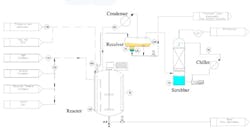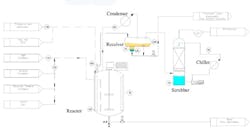Process Puzzler: How To Cope With Glue-Processing and Staff-Conflict Problems
This Month’s Puzzler
My company sells hot melt glue, and I’ve been sent to a customer, ostensibly to participate in a hazard and operability (HAZOP) study about the processing of the glue — but in reality to settle a feud between the customer’s production manager and its corporate safety engineer.
In the customer’s process (here’s the figure), hot melt first flows from a feed tank through a rotary screen. Then a high-pressure gear pump sends the fluid through an electric heat exchanger. After the exchanger, the melt goes to a duplex filter. Finally, it passes either to spray guns or gets recirculated to the tank. The hot melt should be between 350 and 370°F for the spray guns; its flash point is 400°F — production sometimes runs up to 395°F. The tank is maintained at 200°F by an electric heater when the line is down for a day or so.
In addition to the high temperature issue, I see several other problems in the skid that I would like to address to keep the customer happy: the suction rotary screen cakes up; the electric exchanger fouls; and the spray gun flows sometimes are erratic. Cleaning can be a challenge with our product, so we recommend alcohol/water recirculation at 180°F; I only sell the glue — I don’t know much about the cleaning steps. The safety engineer says the alcohol being used is the one my company recommended.
The production manager recently installed a steam condensate system to clean the paraffins and burnt resin that can accumulate. The safety engineer is concerned. He claims the return valve has been sized only for blocked flow to protect the gear pump and is not a proper relief device; he believes that alcohol or steam will be in two phases if relief is needed. The production manager strongly disagrees about the two phases. The safety engineer also is irked because the system was put in without his knowledge; the production group claims it did a ‘what-if” HAZOP. The safety engineer is talking about replacing our hot melt with something less dangerous. I don’t want to lose the customer — what do I do?
[javascriptSnippet ]
Educate Yourself Immediately
It is crucial that you get an agreement between the safety engineer and production engineer before risking anything in a HAZOP. I assume they’re doing a full HAZOP, not another what-if. Before that happens, you’ve got homework.
First, go through the cleaning processes with your application engineers. Besides step-by-step processing, you want background information. For instance, what do other customers do? What problems could arise with the alcohol/water method? Next, reverse-engineer the steam/condensate method the production engineer is using. I suspect your engineers will have something to say about the corrosive effects of steam condensate on steel, particularly in the gear pump.
After this, work on a couple of strategic items. Find out who designed the process, and which other customer personnel might take part in the HAZOP or in subsequent process changes. Make a list and start learning about these people.
If possible, arrange a trip to see the process. Talk to the engineers and, especially, the operators, mechanics and electricians. Look at the data sheets for all the equipment. In particular, review the electrical area classification maps — not just for the area of the skid — to assess whether classifications are okay.
A key concern obviously is operation within the 350–370°F range of the hot melt. If the system operates above 370°F, with a flash point of 400°F, the electrical components must be Class 1, Division 1, probably Group D. Approach this topic carefully with the production manager. The safety manager already is feeling an itch he can’t scratch. You want them to sort it out without getting into fisticuffs.
Before the HAZOP, hold separate, frank discussions with each of them and feed them suggestions. Then, presuming tempers have settled down and a consensus has formed, bring them together. Remember, the last thing you want is to go into the HAZOP with an air of uncertainty. You’re the outsider; you’ll be the bad guy. (If the meeting works out, you may want to segue into selling them other products, like a more expensive hot melt or a cleaning agent.)
Now, let’s consider the relief situation. A return valve is designed to protect the pump, which is rated at 400 psi — it won’t respond well to over-pressure from steam condensate. Given the nature of melt, i.e., the presence of paraffins, I’d forget about a PSV and instead recommend a rupture disc sized for two-phase flow. Although it’s not your place to size reliefs and you don’t want the legal exposure by doing so, you could suggest sizing the disc for a fully open steam control valve. That seems like the worst-case scenario. For rupture discs, refer to these websites: Sizing Rupture Disks and How to size a rupture disk vent line.
You may want to broach in private with the customer a few other improvements: 1) relocating the return valve discharge at the pump inlet; 2) maintaining the minimum temperature at 200°F; 3) ensuring the heat tracing for the pipe and equipment is inspected regularly; and 4) checking if the rotary screen mesh is it too fine and is intact. Other topics also are worth discussing. Should the returned melt go to the tank, not the pump, to avoid risking pump damage? Is the minimum temperature of 200°F too high, even with N2 padding of the tank to preserve the melt from O2 exposure and browning? Is the frequency of pipe inspection adequate (given that failure of heat tracing anywhere in the pipe will cause a catastrophic failure of the entire system)? Should flanges be added for easier removal of the pipe to reduce downtime? What size strainer mesh is optimum for keeping gelled melt out of the pump and minimizing how often the strainer needs cleaning? (It’s sensible to check with someone at the pump vendor about such pump-related issues prior to this meeting.)
Dirk Willard, consultant
Wooster, Ohio
June’s Puzzler
OSHA is investigating us after an incident involving our phosgene reactor. We make a ketone in it by adding phosgene to dimethyl aniline (DMA) using ZnCl2 as catalyst and toluene as solvent. The process consists of a reactor, condenser, receiver and 4%-caustic scrubber (Figure 1).
Figure 1. Incident occurred after sending fresh, rather than recycled, toluene to the reactor.
Normally, we use recycled toluene. However, on the night of the incident, operators found the toluene was contaminated with byproducts, trace water and hydrochloric acid. So, they added fresh toluene to the reactor after purging the vessel with hot nitrogen.
As part of the startup procedure, they sent phosgene to the reactor to eliminate any water present. The operators didn’t see any temperature rise, which would have indicated water was present. So, they added more phosgene as well as DMA to the reactor, and then heated it to 150°F with hot water and steam. Instead of rising steadily, the temperature suddenly climbed to over 250°F before the pressure control valve went to 100%. Shortly after that, the pressure safety valve opened. Our crew sheltered in place; tests show no phosgene was released. However, OSHA is involved because an operator near the scrubber was hurt when the flange close to the condenser leaked. Our investigation indicates an operator likely was to blame for the incident. Do you agree? What do you think caused the event? Can you suggest any process improvements?
Send us your comments, suggestions or solutions for this question by May 13, 2016. We’ll include as many of them as possible in the June 2016 issue and all on ChemicalProcessing.com. Send visuals — a sketch is fine. E-mail us at [email protected] or mail to Process Puzzler, Chemical Processing, 1501 E. Woodfield Rd., Suite 400N, Schaumburg, IL 60173. Fax: (630) 467-1120. Please include your name, title, location and company affiliation in the response.
And, of course, if you have a process problem you'd like to pose to our readers, send it along and we'll be pleased to consider it for publication.

